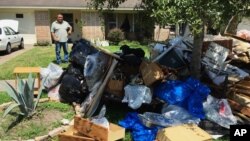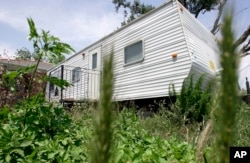In a 2017 hurricane season that has already seen two monster storms, Harvey and Irma, manufactured homes are turning out to be just a small fraction of the federal government's plan to deal with displaced people, with only 1,700 trailers available.
Where exactly the Federal Emergency Management Agency plans to send those trailers, Texas or Florida, is not yet clear. But what is clear is they will only be used as a last resort.
That's in stark contrast to 2005, when 144,000 FEMA trailers became symbols of the troubled federal response to Hurricanes Katrina and Rita after lawsuits accused some of those units of being riddled with high levels of cancer-causing formaldehyde.
FEMA's new model for monster storms honed in the wake of 2012's Superstorm Sandy puts the emphasis on paying for hotels and apartments for temporary housing. That, along with money for super-fast fixes that allow people to move back into their own homes as quickly as possible, even before all the repairs are done.
"Our role is to provide sort of the bridge to get through the disaster,'' FEMA spokesman Kurt Pickering said Saturday. "We are not intended to make people or households back the way they were before, to make them whole. We're designed to get them through the emergency.''
A joint state and federal housing task force in Austin is working with FEMA on the best way to allocate resources. But those affected are far more likely to get government support by way of a few weeks at a hotel, a couple of months of rent in an apartment or a check for repairs, than a FEMA trailer.
"To put a mobile home or travel trailer out there is a significant expense — it really is the option of last resort,'' said Mark Miscak, an emergency management consultant and former director in FEMA's recovery division.
That's the way it's playing out so far after Harvey, which damaged or destroyed more than 210,000 homes across southeast Texas, mostly from the effects of floodwaters from an epic downpour of nearly 52 inches.
FEMA is picking up the tab for hotel rooms spread across Texas for about 60,000 people affected by the storm for up to two weeks. The agency is also paying a couple months' rent at the government's fair market rate for 27,000 additional households.
So who might get a trailer?
It might be people like the Ochoa family of hard-hit southwest Houston, with parents and two grown siblings still sleeping in their heavily damaged, moldering home, its skeletal walls recently stripped of soggy drywall.
Claudia Ochoa, 21, said FEMA offered to put her family up in motels but they were located in cities four to five hours away and they couldn't afford to abandon their jobs.
"If we had some money, we would leave, but we don't,'' she said as her 5-year-old son played on a couch salvaged from the storm. FEMA sent a $500 check for food and cleaning supplies, Ochoa said, but the family is still hoping for a more permanent solution.
The Ochoas' 58-year-old neighbor, Salvador Cortez, is also sleeping in his musty, flood-gutted home. Cortez said he's received no money or housing options from FEMA yet, despite repeated phone calls. But he didn't want to continue imposing on his son, where his wife has been staying with four other people.
Going into the current hurricane season, FEMA had 1,700 trailers on hand in staging areas in Alabama and Maryland. It has put out bids for another 4,500, but officials could not say when they would be ready to meet needs arising from Harvey, Irma and potentially future storms.
FEMA spokesman Bob Howard stressed the units are of much higher quality and do not have the formaldehyde problems of the trailers of the past, which resulted in multimillion-dollar lawsuit payouts to survivors who lived in them for years after the storms.
The new trailers, which cost FEMA between $40,000 and $60,000 each, range in size from one bedroom to three bedrooms, and are equipped with sprinklers and other features designed for longer-term habitation.
"They're built to house survivors much longer than previous units used after disasters,'' FEMA said in a release last year announcing its new fleet, "an important consideration because rebuilding can take months or even years.''
Still, FEMA stressed in a January 2017 release, units "are not intended to be a permanent housing option for flood survivors.''











